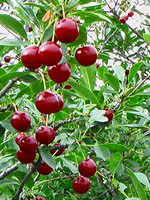Mon-Fri 9am - 5pm Mountain time
Juliet Cherry vs Manchurian Apricot
Prunus x kerrasis Juliet
Prunus armeniaca var. mandshurica
Juliet Cherry is a cold-hardy dwarf sour cherry. The deep burgundy fruit are known for being sweeter than other varieties, often considered one of the sweetest dwarf sour cherries. They are well suited to fresh eating, baking, and preserves. In the spring, beautiful white flowers cover the branches, adding ornamental value.
Juliet Cherry was developed at the University of Saskatchewan. It is recommended to grow dwarf sour cherries as a shrub rather than a small tree. The shrub form tends to bear fruit earlier and is less susceptible to winterkill.
Sour cherries are self-fertile; however, planting with additional varieties for cross-pollination can increase yields.
Manchurian Apricot is a winter-hardy relative of the native plum. This tree can stand some drought, but will not handle standing water or saturated moist soils. It can be used in shelterbelts, hedges, or as an ornamental. Manchurian Apricot will also attract songbirds, rabbits, and other rodents if left uncontrolled.
This tree will produce fruit once it reaches maturity at between two and five years old. Other famous cultivars of Manchurian Apricot include Scout Apricot, Moongold, and many more.

